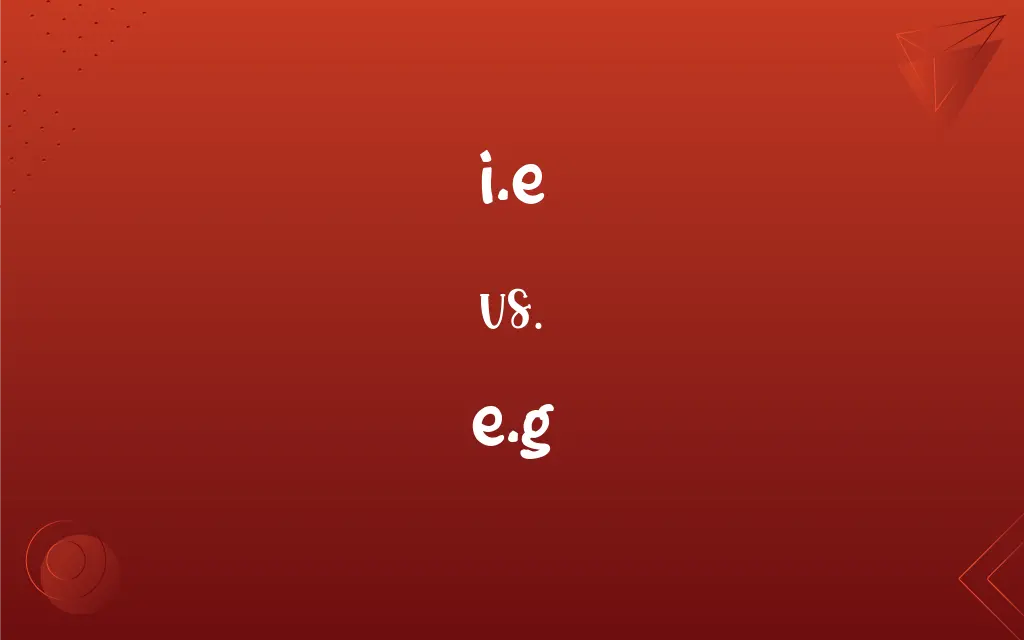i.e vs. e.g: What's the Difference?
Edited by Janet White || By Harlon Moss || Updated on October 11, 2023
"I.e." means "that is" and clarifies or rephrases a statement, while "e.g." means "for example" and introduces examples related to a statement.

Key Differences
The term "i.e.," which is an abbreviation for the Latin phrase "id est," serves to provide additional clarification or a restatement of the preceding notion. When you say "i.e.," you mean "that is" or "in other words." It’s used to provide a further explanation that ensures the statement is clearly understood. On the other hand, "e.g." originates from the Latin phrase "exempli gratia," which translates to "for example." It is utilized to present examples that illustrate the preceding statement.
For "i.e.," it's critical to recognize its role in providing synonymous information or clarification about a specific statement. It delineates the assertion with a rephrase or an alternative description, ensuring the original sentiment is conveyed accurately. Conversely, "e.g." doesn’t seek to clarify with synonymous information, but rather it aims to elucidate a general statement by providing instances or examples that fall under the umbrella of the preceding concept.
In context, "i.e." acts as a connector that introduces a parallel or clarifying statement. For example, if one says, "I enjoy playing string instruments, i.e., instruments that produce sound through vibrating strings," the latter part rephrases and specifies the former. On the flip side, "e.g." introduces specific examples that fall within a broader category without necessarily providing an exact rephrase or clarification. It extends the statement by offering instances: "I enjoy playing string instruments, e.g., the violin or cello."
Utilizing "i.e." and "e.g." correctly in a sentence also involves applying appropriate punctuation. Both "i.e." and "e.g." should be preceded by a comma and followed by a comma in American English, ensuring that the statement is appropriately isolated and does not disrupt the flow of the sentence. For example, “She enjoys reading mystery novels, i.e., novels that involve some element of a puzzle to be solved.” Alternatively, “She enjoys reading mystery novels, e.g., works written by Agatha Christie.”
Lastly, it's essential to underscore that "i.e." and "e.g." are often misused interchangeably due to their roles in providing additional information. A precise understanding of "i.e." as a clarifying tool and "e.g." as an example-providing tool ensures that communication is clear, specific, and accurate. Both abbreviations serve valuable, albeit distinct, functions in elucidating and expanding upon statements in written communication.
ADVERTISEMENT
Comparison Chart
Meaning
That is
For example
Origin
Latin "id est"
Latin "exempli gratia"
Purpose
Provides clarification or rephrasing
Introduces examples
Usage in a Sentence
Used to introduce a synonymous statement
Used to introduce one/more examples
Punctuation
Typically followed by a comma in English
Also followed by a comma in English
ADVERTISEMENT
i.e and e.g Definitions
i.e
"I.e." is used to provide a more detailed explanation or clarification of a preceding statement.
He prefers to eat tropical fruits, i.e., those that grow in climates where it is warm all year round.
e.g
"E.g." is employed to bring forth instances that exemplify a preceding general idea.
She excels in artistic activities, e.g., painting and sculpting.
i.e
"I.e." introduces a statement that reiterates a previous one with a different phrase or additional details.
She practices aerobics, i.e., a type of exercise that combines rhythmic activity with stretching.
e.g
"E.g." serves as a bridge to present specific instances that fit into a broader category.
I love to eat berries, e.g., strawberries and blueberries.
i.e
"I.e." is utilized to ensure that a prior statement is accurately and thoroughly understood by offering additional information.
He only listens to classic rock, i.e., rock music from the 1960s to the 1980s.
e.g
"E.g." aims to clarify a general statement by giving one or more examples.
Consider aquatic animals, e.g., sharks and dolphins, when designing the exhibit.
i.e
"I.e." delivers a clearer or more specific portrayal of an aforementioned concept or statement.
He has a penchant for playing board games, i.e., games that involve moving pieces on a pre-marked surface or board.
e.g
"E.g." introduces illustrative examples of the previously mentioned concept.
She enjoys playing sports, e.g., soccer and tennis.
i.e
"I.e." serves as a tool to introduce a synonymous term or phrase that mirrors a prior statement.
She adopted a feline, i.e., a domestic cat.
e.g
"E.g." is utilized to showcase examples without providing an exhaustive list.
He visited several countries in Europe, e.g., France and Italy.
FAQs
How is "e.g." used in a sentence?
"E.g." introduces examples: "He enjoys outdoor activities, e.g., hiking and fishing."
What does "i.e." stand for?
"I.e." stands for "id est" in Latin, translating to "that is" in English.
Can "i.e." introduce an example?
Typically, "i.e." introduces clarification or synonymous information, not examples.
Can a sentence end with "i.e."?
Ideally, "i.e." should be followed by additional clarifying information, not end a sentence.
How do I choose between "i.e." and "e.g."?
Use "i.e." to clarify/rephrase and "e.g." to provide examples.
Should "i.e." and "e.g." be italicized?
They are typically not italicized in general English writing.
Can "e.g." start a sentence?
While possible, starting a sentence with "e.g." is often discouraged in formal writing.
Is "etc." necessary after "e.g."?
No, it's redundant to use "etc." after "e.g." as both imply an incomplete list.
Is it correct to write "i.e.," and "e.g.," with commas?
Yes, in American English, they are often followed by a comma.
How is "i.e." used in a sentence?
"I.e." is used to introduce a clarifying statement: "She works in the financial sector, i.e., banking."
Can "e.g." be used to introduce a clarification?
No, "e.g." is used to introduce examples, not to clarify or rephrase a statement.
Should examples introduced by "e.g." be exhaustive?
No, "e.g." introduces one or more examples, not an exhaustive list.
Do British English writers follow "i.e." and "e.g." with a comma?
Not always, British English writers might omit the comma.
Can "i.e." introduce a contradiction?
No, "i.e." provides clarification, not contradiction or alternative information.
Should "i.e." and "e.g." always be abbreviated?
In English writing, yes, but they can be replaced with "that is" and "for example," respectively.
Can I use "i.e." and "e.g." in academic writing?
Yes, but ensure you use them correctly and consider your institution’s style guide.
What does "e.g." stand for?
"E.g." stands for "exempli gratia" in Latin, which means "for example" in English.
Can "i.e." and "e.g." be used interchangeably?
No, "i.e." provides clarification while "e.g." provides examples.
Should a comma follow "i.e." and "e.g."?
In American English, a comma usually follows both "i.e." and "e.g."
Are "i.e." and "e.g." used in formal writing?
Yes, but they might be used less frequently or replaced with their English equivalents in very formal texts.
About Author
Written by
Harlon MossHarlon is a seasoned quality moderator and accomplished content writer for Difference Wiki. An alumnus of the prestigious University of California, he earned his degree in Computer Science. Leveraging his academic background, Harlon brings a meticulous and informed perspective to his work, ensuring content accuracy and excellence.
Edited by
Janet WhiteJanet White has been an esteemed writer and blogger for Difference Wiki. Holding a Master's degree in Science and Medical Journalism from the prestigious Boston University, she has consistently demonstrated her expertise and passion for her field. When she's not immersed in her work, Janet relishes her time exercising, delving into a good book, and cherishing moments with friends and family.































































